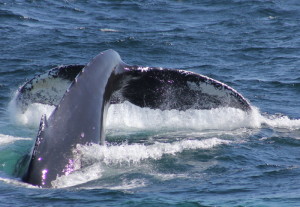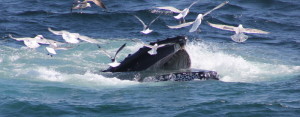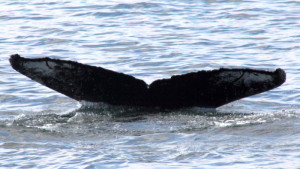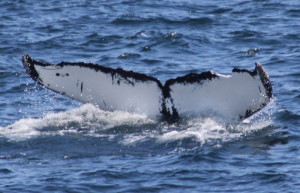Naturalist Notebook – April 19 – April 25
We set sail on the morning of April 19 to calm breezes and a clearing sky to find numerous cetaceans, large and small moving about the bay in a seemingly random fashion. Three types of baleen whales, humpbacks, fin whales, and Minkes were accompanied by small groups of Atlantic white-sided dolphins. When you hear your whale watch captain point out a group of Lags, he is referring to these dolphins by a shortened version of their scientific name, Lagenorhynchus acutus.
As the day went on and the wind increased, the large baleen whales spread out and spotting the Lags became more difficult. Fortunately, the humpback whales outside of the bay began to feed at the surface. Fern, a female humpback first seen in 1983 was particularly active in her feeding display, repeatedly kick-feeding and emerging at the surface with a mouthful of fish.
Fern’s big feed show was rivaled by a sight of a skim feeding right whale at Race Point. At this time of year, the critically endangered North Atlantic right whale is getting its fill of the last patches of Calanus finmarchicus, its favorite zooplankton prey, before heading to the Great South Channel for the late spring and early summer. All North Atlantic right whale sightings are reported to NOAA/NMFS, who use this information to warn mariners in the area to watch out for this ship-strike prone whale. Recently, a smartphone app was developed to give mariners the most up to date information about the presence of right whales in North Atlantic waters. It highlights areas to be avoided to reduce the risk of collision, as right whales are very difficult to see at the surface. To learn more about the app, click here.
April 20th was a breezy morning, and we quickly found big numbers of whales just to the south of Stellwagen Bank. Humpback whales, including Fern, Ventisca, and Twinkle were feeding on fish in small groups of 2s and 3s. Humpback whales will sometimes feed cooperatively, although what sometimes appears to be cooperative feeding on the surface actually involves one or two sneaky humpbacks entering a fish-filled bubble cloud constructed by another whale!
A true highlight of the morning’s trip was amazing looks at three lunging fin whales. Like humpbacks, fin whales feed on small fish, but their feeding behavior is very different. Rather than generating bubbles, fin whale roll 90 degrees on their sides and lunge through schools of prey on their sides.
The afternoon’s trip found a group of six different humpbacks feeding in a similar location. We noticed that Scylla’s 2008 calf, still yet to be named, still has a small divot-shaped scar behind its blowholes. This could be the result of a shipstrike, which are sadly, not uncommon occurrences for our humpbacks. Scylla’s 2008 calf still doesn’t have a name. Based on the markings on her flukes, what do you think it should be?
On April 21st we found another North Atlantic right whale very close to the beach near Race Point Light. It can be shocking to see such a large whale so close to shore, but stranding events are rare for large baleen whales. In fact, as close as 50 feet from shore there is a steep drop-off that can be as deep as 120 feet. The right whale did not appear to be feeding this time. Instead, it lifted its head out of the water in a spyhop, thought to be a behavior related to curiosity. What are those crusty markings on the whales’ head? They’re called callosities. Colonies of lice congregate in the cornified skin atop a right whale’s head, and these patterns are what allow researchers to identify these whales as individuals.
The humpbacks were also showing active surface behavior. Eruption, a 13 year old female, breached repeatedly alongside another unidentified humpback whale, before settling down into some chin breaches. Also seen today were Aerospace, Bounce, Centipede, and Crystal. Crystal is one of our favorite whales to see. Her mother, Salt, is a yearly visitor to Stellwagen Bank since at least 1975. Crystal was so named because she is “a little piece of Salt”.
On the way back in to the harbor we noticed about 10 Harbor seals hauled out Long Point. Their very red fur made them easy to spot. This reddish tinge is due to iron oxide deposits on their hair shafts.
After a few “blow days” — cancellations due to high winds — we decided to venture out again on April 24th. Unfortunately, we did not have much luck on our morning trip. When we discovered that in Cape Cod Bay alone there were six foot seas, we decided we couldn’t risk leaving the protected waters of Cape Cod Bay, and instead headed to the southwest. Although the captain and the first mate spotted one tall blow 2 miles away near the Herring Cove Bathhouse, it was too rough to get to it and we eventually had to return to the dock.
We had a bit more luck on the afternoon trip, although it was quite bouncy! It was difficult going to get to the spouts without taking the seas on the beam, but persistence payed off with some good looks at a fin whale and some even better looks at a humpback. Even with the seas, a few passengers were first to spot a small group of 10-20 Atlantic white-sided dolphins before they disappeared.
It was still a bit choppy on April 25th, but we had significantly less trouble getting out to Race Point, which was the place to be. The rip where the waters of Cape Cod Bay meet the waters of the rest of the Gulf of Maine was filled with life. When these two water bodies converge, nutrients and food are often pushed to the surface, causing a hot spot of productivity. Indeed, the feeding today was out of control! The rip was loaded with Humpbacks, Fin whales, and Atlantic white-sided dolphins all day long. Circus, Tracer, and Centipede were among the humpbacks chowing down on huge schools of fish.
Gulls and gannets were also enjoying the bounty and they swooped down and dove among our feeding whales, plucking up sand eels and other fish with every dive.













